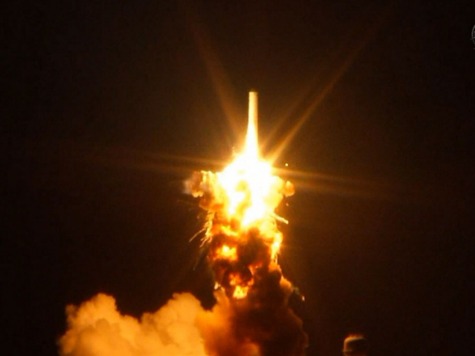
Russia launched a cargo vessel filled with food and supplies from Kazakhstan early Wednesday morning for the International Space Station (ISS). The launch occurred only hours after America’s attempt to refuel the station exploded on takeoff Tuesday evening.
The Soyuz-2.1a rocket took off at 10:09 a.m. Moscow time and docked at the station only six hours later. Russia used this rocket, which was first tested in November 2004, instead of the Soyuz-U-PVB. The Soyuz-2.1a rocket is larger. It “carries over 2.5 tons of cargo, including fuel, foods, water and oxygen as well as various scientific equipment.”
The Antares, America’s unmanned rocket, carried 2.5 tons of equipment, including “freeze-dried Maryland crabcakes [sic] for a Baltimore-born astronaut who’s been in orbit for five months.” Orbital Sciences built the rocket, but does not know if the engine is to blame, which dates back to the Soviet era. The press asked executive vice president Frank Culbertson about the “refurbished Russian engine hardware.” From FOX News:
Orbital uses AJ26 rocket engines from Aerojet Rocketdyne. The engines are a “commercial derivative” of the NK-33 engine that was initially developed to power the Russian N-1 rocket on a lunar mission in the early 1970s, according to Sacramento, Calif.-based Aerojet.
“Basically, this was an engine that was designed to carry cosmonauts to the moon – a number of them were bought by Aerojet several years ago to be refurbished and ‘Americanized’ and provided to American industry,” he said. “It’s an extensively tested engine – it’s very robust and rugged.”
It is not easy to find rocket hardware within the United States. This means American companies must look at foreign technology. The lack of funding from the Bush and Obama administrations hurts the space program.
“When Orbital Sciences decided to develop what turned out to be the Antares rocket almost ten years ago, it examined the supply of rocket engines from around the world and decided that the former NK-33 engines, which another U.S. company had already purchased from Russia, gave the best mix of cost and performance,” said John Logsdon, professor emeritus of political science and international affairs at George Washington University’s Space Policy Institute. “One can criticize that choice in retrospect, but it was a commercial decision, not symptomatic of anything except the U.S. not investing for many years in new propulsion capabilities.”

COMMENTS
Please let us know if you're having issues with commenting.